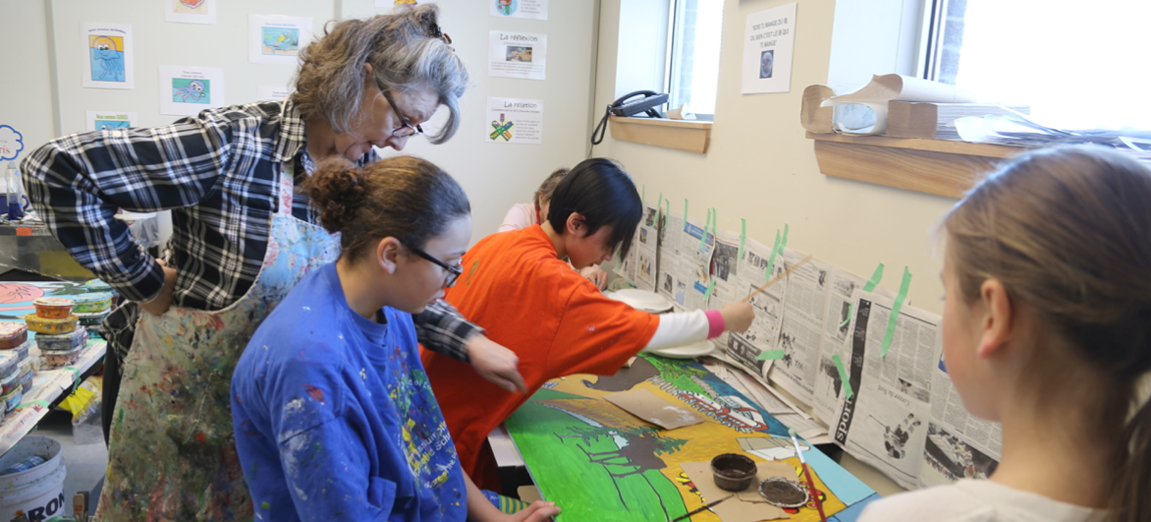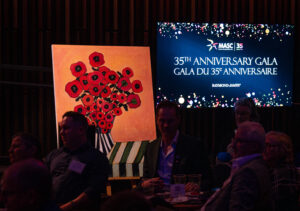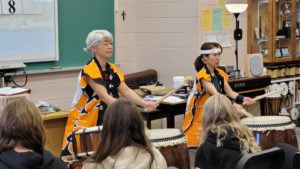Interview: Nicole Bélanger helps develop critical thinking and a sense of belonging through group art
By Jessica Ruano | January 5, 2022

This interview was originally published on Apt613.ca
Nicole Bélanger is a visual artist who specializes in murals as collaborative works of art. In schools or the community, her emphasis is on group work, both in conceptualization and creation. Nicole believes that the power of energy comes from the creative efforts of the group and that there is room for everyone in the world of creativity. In this interview, Nicole talks about adapting her work in communities for the pandemic and having respect for an artist’s career.

Nicole Bélanger. Photo provided by MASC.
MASC: In your mural workshops, you provide a creative and artistic learning environment for students and encourage a team spirit. What are the skills the students learn in your workshops? And what are the benefits of working together?
Nicole: The idea of creating a group work is powerful and the students quickly discover the pleasure of group work. They develop many skills, such as the power of critical thinking, positive discussion, the challenges of the work, and a sense of belonging. On a practical level, there are the skills of mixing colours, how to manipulate a brush, how to do shading, and more.
You often say that your mother is a great source of inspiration for your work. In turn, how do you hope to inspire young people in your workshops? What are the important values you try to pass on, and how do you go about it?
It is very common to discuss the life of an artist during a creative session with me. What I always share with the participants is the importance of artistic discipline. I refer to all the great artists, whether it’s music, painting, or dance, and point out the time these artists invested in their work before they got to where they are now. I like to tell them that being an artist is as important as any other career and that their work has value.

Nicole paints with seniors. Photo provided by MASC.
As a result of the COVID-19 restrictions, many MASC artists have had to adapt their approach to creating and teaching art. You came up with the idea of “art kits” that could be delivered to individual participants. What are these kits and where did you get the idea?
In my case, since I had already developed the digital mural, the concept of remote assembly was an established idea. The kits are essentially the materials needed, but divided and delivered so that each participant can work independently. For example, in the case of the watercolour project, each participant receives watercolour papers, small individual containers for paint, brushes, an example of a piece of work, and a very detailed explanation sheet. There is a lot of work and planning involved in putting the kits together.
As a member of MASC, what do you gain from offering your workshops in schools and in the community? How has working with students inspired your overall practice?
This question is very important. For a long time, I was not convinced of the importance of my work with MASC to my private practice. What I can say today, with certainty, is that my work with children and teens informs my private practice. As I share my knowledge and work with the material in a concrete way, my craft as an artist is strengthened.

Nicole teaches a kids’ workshop. Photo provided by MASC.
Why do you think it is important for our local community to have access to professional artists?
Creativity is now a sought-after and respected aspect of all learning. Larger organizations recognize the importance of this. What we as professional artists offer our local community is an important source of information related to creative thinking. The impact of these contacts is limitless, as each child or teen or adult who comes into contact with a professional artist comes away with something that will in turn influence others.
Latest News
View All Articles



